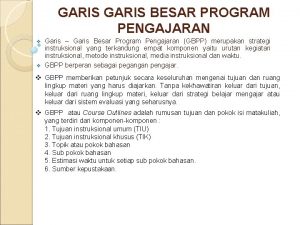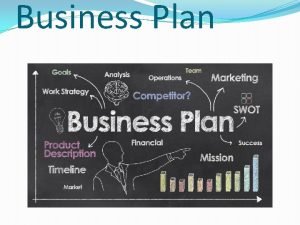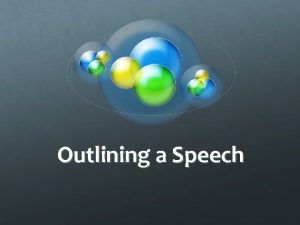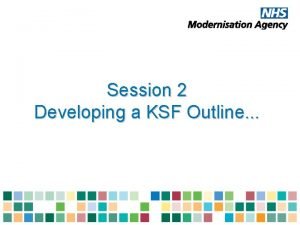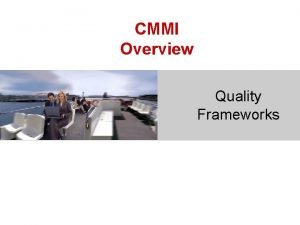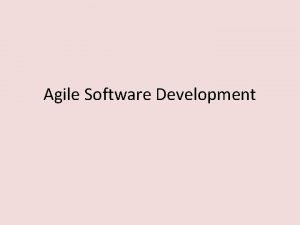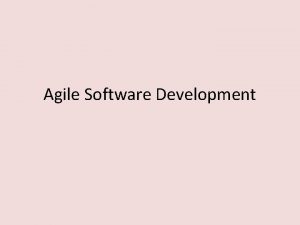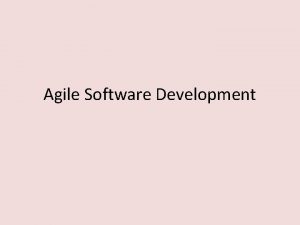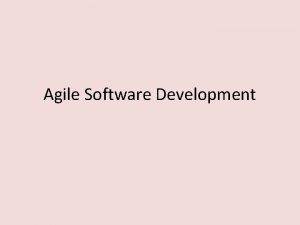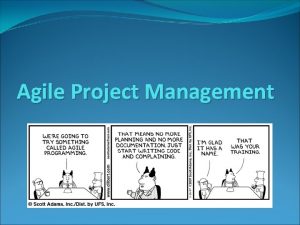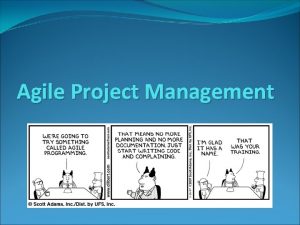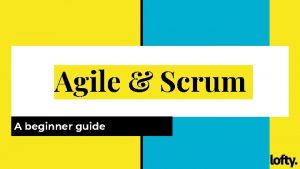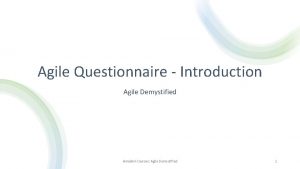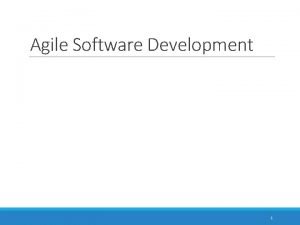AGILE DEVELOPMENT OUTLINES 1 QUICK LOOK OF AGILE























- Slides: 23

AGILE DEVELOPMENT OUTLINES : 1. QUICK LOOK OF AGILE DEVELOPMENT 2. AGILITY 3. AGILITY PROCESS 4. PLAN DRIVEN AND AGILE DEVELOPMENT 5. EXTREME PROGRAMMING (XP) 6. ADAPTIVE SOFTWARE DEVELOPMENT (ASD) 7. SCRUM 8. CASE STUDY

SUMBER PUSTAKA 1. Pressman, Roger S. 2010. Software Engineering, A Practitioner’s Approach, 7 Th Edition. Mc. Graw Hill International Edition. 2. Sommerville, Ian. 2011. Software Engineering, 9 Th Edition. Addison. Wesley

Alistair Cockburn (2002) : “they forget the frailties of the people who build computer software. Software engineers are not robots. They exhibit great variation in working styles; significant differences in skill level, creativity, orderliness, consistency, and spontaneity. Some communicate well in written form, others do not. ” “Because consistency in action is a human weakness, high discipline methodologies are fragile. ” *Cockburn, A. 2002. Agile Software Development. Addison Wesley.

QUICK LOOK / INTRODUCTION What is it ? Who does it ? Why is it important ? What are the steps ? What is the work product ? How do I ensure that I’ve done it right ?

QUICK LOOK / INTRODUCTION What is it ? Agile software engineering combines a philosophy and a set of development guidelines. PHILOSOPHY : encourages customer satisfaction and early incremental delivery of software; small, highly motivated project teams; minimal software engineering work products; and overall development simplicity. THE DEVELOPMENT GUIDELINES : active and communication between developers and customers. continuous

QUICK LOOK / INTRODUCTION Who does it ? Software engineers and other project stakeholders (managers, customers, end users) work together on an agile team - a team that is self-organizing and in control of its own destiny.

QUICK LOOK / INTRODUCTION Why is it important ? The modern business environment that spawns computer-based systems and software products is fast-paced and ever-changing. Agile software engineering represents a reasonable alternative to conventional software engineering for certain classes of software and certain types of software projects. It has been demonstrated to deliver successful systems quickly.

QUICK LOOK / INTRODUCTION What are the steps ? Agile development might best be termed “software engineering lite. ” The basic framework activities -- communication, planning, modeling, construction, and deployment. But they morph into a minimal task set that pushes the project team toward construction and delivery.

QUICK LOOK / INTRODUCTION What is the work product ? Both the customer and the software engineer have the same view—the only really important work product is an operational “software increment” that is delivered to the customer on the appropriate commitment date.

QUICK LOOK / INTRODUCTION How do I ensure that I’ve done it right ? If the agile team agrees that the process works, and the team produces deliverable software increments that satisfy the customer, you’ve done it right.

AGILITY Ivar Jacobson (2002) : “Agility has become today’s buzzword when describing a modern software process. Everyone is agile. An agile team is a nimble team able to appropriately respond to changes. Change is what software development is very much about. Changes in the software being built, changes to the team members, changes because of new technology, changes of all kinds that may have an impact on the product they build or the project that creates the product. Support for changes should be built-in everything we do in software, something we embrace because it is the heart and soul of software. An agile team recognizes that software is developed by individuals working in teams and that the skills of these people, their ability to collaborate is at the core for the success of the project. ” * Jacobson, I. , “A Resounding ‘Yes’ to Agile Processes—But Also More, ” Cutter IT Journal, Vol. 15, No. 1, January 2002, pp. 18 -24.

AGILITY Pressman (2010) : “agility is more than an effective response to change. It also encompasses the philosophy. It encourages team structures and attitudes that make communication (among team members, between technologists and business people, between software engineers and their managers) more facile. It emphasizes rapid delivery of operational software and de-emphasizes the importance of intermediate work products; it adopts the customer as a part of the development team and works to eliminate the “us and them” attitude that continues to pervade many software projects; it recognizes that planning in an uncertain world has its limits and that a project plan must be flexible. “

AGILE PROCESS Agile methods are incremental development methods in which the increments are small and, typically, new releases of the system are created and made available to customers every two or three weeks. They involve customers in the development process to get rapid feedback on changing requirements. They minimize documentation by using informal communications rather than formal meetings with written documents (Sommerville, 2011).

AGILE PROCESS Agile philosophy : üIndividuals and interactions over processes and tools üWorking software over comprehensive documentation üCustomer collaboration over contract negotiation üResponding to change over following a plan (Sommerville, 2011; Pressman, 2010).

AGILE PRINCIPLES (Sommerville, 2011)

PLAN DRIVEN AND AGILE DEVELOPMENT (Sommerville, 2011)

PLAN DRIVEN AND AGILE DEVELOPMENT In a plan-driven approach, iteration occurs within activities with formal documents used to communicate between stages of the process. For example, the requirements will evolve and, ultimately, a requirements specification will be produced. This is then an input to the design and implementation process. In an agile approach, iteration occurs across activities. Therefore, the requirements and the design are developed together, rather than separately.

AGILE SOFTWARE DEVELOPMENT 1. Extreme Programming (XP) 2. Adaptive Software Development (ASD) 3. Scrum 4. Dynamic Systems Development Method (DSDM) 5. Crystal 6. Feature Driven Development (FDD) 7. Lean Software Development (LSD) 8. Agile Modeling (AM) 9. Agile Unified Process (AUP)

EXTREME PROGRAMMING (XP) Extreme Programming uses an object-oriented approach as its preferred development paradigm and encompasses a set of rules and practices that occur within the context of four framework activities: planning, design, coding, and testing.

EXTREME PROGRAMMING (XP) The XP Debate : 1. Requirements volatility. 2. Conflicting customer needs 3. Requirements are expressed informally 4. Lack of formal design

ADAPTIVE SOFTWARE DEVELOPMENT (ASD) Adaptive Software Development (ASD) has been proposed by Jim Highsmith as a technique for building complex software and systems. The philosophical underpinnings of ASD focus on human collaboration and team self-organization.

SCRUM Scrum principles are consistent with the agile manifesto and are used to guide development activities within a process that incorporates the following framework activities: requirements, analysis, design, evolution, and delivery. Scrum is a process framework that has been used to manage complex product development since the early 1990 s. Scrum is not a process or a technique for building products; rather, it is a framework within

SCRUM
 Look down to the right
Look down to the right Quick find vs quick union
Quick find vs quick union Collision forces quick check
Collision forces quick check Evaluation primaire rcr
Evaluation primaire rcr An outline
An outline Teaching outlines
Teaching outlines Prison ministry training manual download
Prison ministry training manual download Commercial law outline
Commercial law outline Four main components for effective outlines
Four main components for effective outlines A business plan is a document that outlines
A business plan is a document that outlines Pyelonephritis
Pyelonephritis Elijah and the shunammite woman
Elijah and the shunammite woman Naruto anime outline
Naruto anime outline Two types of outlines
Two types of outlines A haunted house by virginia woolf characters
A haunted house by virginia woolf characters Ksf outlines
Ksf outlines Mucoepidermoid carcinoma pathology outlines
Mucoepidermoid carcinoma pathology outlines Cmmi model outlines
Cmmi model outlines Acts 4 outline
Acts 4 outline Exegetical outline
Exegetical outline The cjis security policy outlines the minimum requirements
The cjis security policy outlines the minimum requirements Model un position paper outlines
Model un position paper outlines Define:visible
Define:visible Acute suppurative appendicitis
Acute suppurative appendicitis





